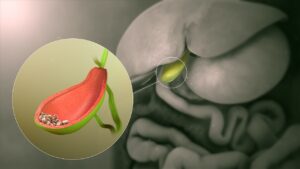Gall stones
 Gallstones form in your gallbladder, the small, pear-shaped organ where your body stores bile. They are pebble-like pieces of concentrated bile materials. Bile fluid contains cholesterol, bilirubin bile salts and lecithin. Gallstones are usually made up of cholesterol or bilirubin that collect at the bottom of your gallbladder until they harden into “stones.”
Gallstones form in your gallbladder, the small, pear-shaped organ where your body stores bile. They are pebble-like pieces of concentrated bile materials. Bile fluid contains cholesterol, bilirubin bile salts and lecithin. Gallstones are usually made up of cholesterol or bilirubin that collect at the bottom of your gallbladder until they harden into “stones.”
Gallstones can be as small as a grain of sand or as big as a golf ball. They grow gradually, as bile continues to wash over them and they collect extra materials. Actually, it’s the smaller stones that are more likely to cause trouble. That’s because smaller stones can travel, while bigger ones tend to stay put. Gallstones that travel may get stuck somewhere and create a blockage.
Symptoms
When a gallstone causes a persistent blockage or an infection, you’ll have symptoms of acute inflammation. This may include:
- Constant pain.
- Fever and chills.
- Heart rate accelerations.
You may also begin to show symptoms of bile accumulating in your bloodstream, such as:
- Sunken eyes.
- Dark-colored pee.
Causes
Excess bilirubin: About 25% of gallstones are made up of excess bilirubin instead of cholesterol. Bilirubin is a byproduct that’s produced when your liver breaks down red blood cells. Certain medical disorders can cause your liver to produce extra bilirubin while doing its job. Some of these include infections, blood disorders and liver disease.
Gallbladder stasis: Your small intestine signals to your gallbladder to send bile when it has fats to digest. When your gallbladder is healthy, it contracts to efficiently move bile out when necessary. But if your gallbladder doesn’t contract well enough, some bile may be left behind. This bile gradually concentrates into a kind of sludge at the bottom of your gallbladder, which then crystallizes.
Estrogen increases cholesterol, and progesterone slows down gallbladder contractions. Both hormones are especially high during certain periods in your reproductive life, such as menstruation and pregnancy. When hormone levels begin to drop in menopause, many people use hormone therapy (HT) to replace them, which elevates them again.
Women and people assigned female at birth are also more likely to gain and lose body fat more frequently. Excessive body fat can translate to extra cholesterol in your blood. Having obesity increases estrogen. On the other hand, rapid weight loss has a similar effect to weight gain. When you lose a lot of body fat at once, it sends an unusually large load of cholesterol to your liver for processing, which ends up in your bile.
PREVENTION
You can reduce your risk of cholesterol gallstones.
Limit fried and fast foods: These foods are usually fried in saturated fats, which promote LDL cholesterol (the “bad” type). If you cook with oil, choose plant oils instead of animal fats.
Replace red meat with fish: Red meat is high in saturated fats, while fish is high in omega-3 fatty acids, which promote HDL cholesterol (the “good” type). The good type helps balance the bad type.
Eat more plants: High-fiber fruits, vegetables and whole grains help to clear out excess cholesterol from your body. Eating more plants can also help you keep your overall weight down.
Lose weight gradually: Dieting to lose weight can help reduce the cholesterol content in your blood. But it’s better to lose weight at a slow, steady pace of one to two pounds a week. Rapid weight loss can encourage gallstones.
